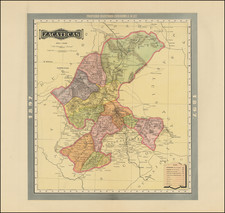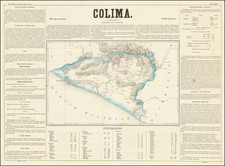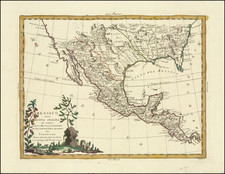Detailed Plan of Mexico City’s Drainage System from a Period of Infrastructure Reform
Plan of Mexico’s capital with the location, width, and depth of its sewage pipes. This knowledge was vital to the city’s growth and was compiled by the Sanitation Commission.
The city is recorded minutely; developed space is shown in grey, with open space in yellow and streets in white. The Alameda is evident with its manicured lawns and walkways. The Zócalo, with its open plaza, is nearby. These well-known landmarks are obvious for their location and size; they also lie along one of the two roads that are marked on the map.
Otherwise, the reader is adrift with regard to wayfinding; this is because the map is thematic, meant to communicate a specific type of information. In this case, that information is the location of the city’s atarjeas, or drainage pipes. The color and type of the line indicates the pipe’s width, as explained in a legend in the upper right corner. There is also a small number perpendicular to each pipe; this indicates the depth of the pipe below street level.
The 1890s saw particular attention paid to the city’s drainage system. The Grand Canal, a feat of modern engineering, was nearing completion by this decade. The recently-built canal de Derivación (1889-90), located south of the city and which was supposed to bring water from Xochimilco, did not function as hoped and even sometimes flooded with sewage, or aguas negras.
Water and waste flow and transportation had always been a concern for the capital city; located as it was on a lake system, it struggled over time with flooding, freshwater, and sanitation. Additionally, the city was growing rapidly by the end of the nineteenth century, requiring more and more infrastructure. Many of these infrastructure issues were addressed by massive public works projects undertaken during the Porfiriato, the period 1876 to 1911 which was dominated by strong-man General Porfirio Díaz.
In the years just before this plan was published, Roberto Gayol made his own plan of the city’s drainage system, along with calculations of how much water they should manage and suggestions for improvements. Gayol’s project, with modifications, was still being discussed in 1898, when he published another plan showing the wider drainage system for the main city pipes. The plan offered here was part of this larger conversation and era of construction, an attempt to communicate about the drainage pipes already laid down and their size.
Rarity
The plan appears to be quite rare. We locate a copy in the Archivo Histórico de la Ciudad de México. This is the first time we have offered this map.










![(Mexican Antiquities - Photography) [Western Facade of the Fourth Palace, Mitla, Oaxaca; Quatrieme Palais, à Mitla, façade occidentale] [Plate 15 from:] Cités et Ruines Américaines](https://storage.googleapis.com/raremaps/img/small/93940.jpg)

![El numero 1 q[ue] se haya en la orilla de la ???ya que corre a San Ysidro es el gran ?? de partida siguencio? la numeracion immediata a los puntos amarillos ?on los ?inderos, hasta? el numero 19 con que vierra en el terreno marcados con la letra C.](https://storage.googleapis.com/raremaps/img/small/65664ba.jpg)
![[Southern Arizona - Sonora] (Restricted) Douglas . . . Sectional Aeronautical Chart](https://storage.googleapis.com/raremaps/img/small/96226.jpg)
